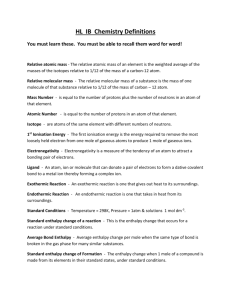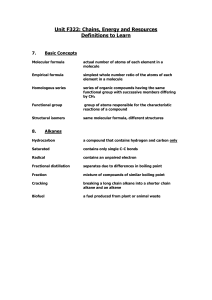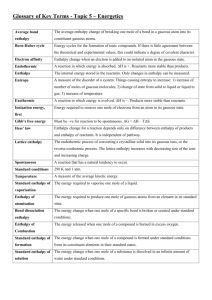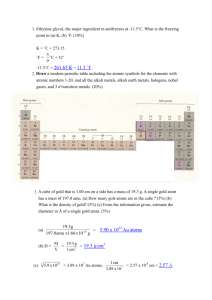a level chemistry - some definitions to learn
advertisement
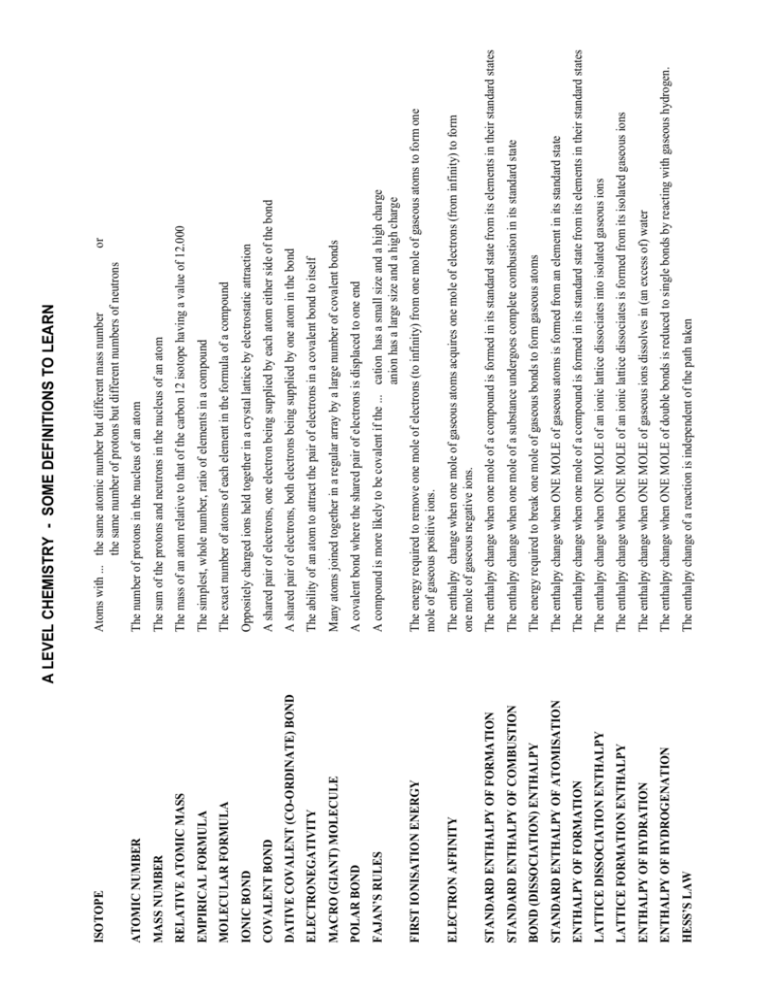
The number of protons in the nucleus of an atom The sum of the protons and neutrons in the nucleus of an atom The mass of an atom relative to that of the carbon 12 isotope having a value of 12.000 The simplest, whole number, ratio of elements in a compound The exact number of atoms of each element in the formula of a compound Oppositely charged ions held together in a crystal lattice by electrostatic attraction A shared pair of electrons, one electron being supplied by each atom either side of the bond A shared pair of electrons, both electrons being supplied by one atom in the bond The ability of an atom to attract the pair of electrons in a covalent bond to itself Many atoms joined together in a regular array by a large number of covalent bonds A covalent bond where the shared pair of electrons is displaced to one end A compound is more likely to be covalent if the ... cation has a small size and a high charge anion has a large size and a high charge The energy required to remove one mole of electrons (to infinity) from one mole of gaseous atoms to form one mole of gaseous positive ions. The enthalpy change when one mole of gaseous atoms acquires one mole of electrons (from infinity) to form one mole of gaseous negative ions. The enthalpy change when one mole of a compound is formed in its standard state from its elements in their standard states The enthalpy change when one mole of a substance undergoes complete combustion in its standard state The energy required to break one mole of gaseous bonds to form gaseous atoms The enthalpy change when ONE MOLE of gaseous atoms is formed from an element in its standard state The enthalpy change when one mole of a compound is formed in its standard state from its elements in their standard states The enthalpy change when ONE MOLE of an ionic lattice dissociates into isolated gaseous ions The enthalpy change when ONE MOLE of an ionic lattice dissociates is formed from its isolated gaseous ions The enthalpy change when ONE MOLE of gaseous ions dissolves in (an excess of) water The enthalpy change when ONE MOLE of double bonds is reduced to single bonds by reacting with gaseous hydrogen. The enthalpy change of a reaction is independent of the path taken ATOMIC NUMBER MASS NUMBER RELATIVE ATOMIC MASS EMPIRICAL FORMULA MOLECULAR FORMULA IONIC BOND COVALENT BOND DATIVE COVALENT (CO-ORDINATE) BOND ELECTRONEGATIVITY MACRO (GIANT) MOLECULE POLAR BOND FAJAN’S RULES FIRST IONISATION ENERGY ELECTRON AFFINITY STANDARD ENTHALPY OF FORMATION STANDARD ENTHALPY OF COMBUSTION BOND (DISSOCIATION) ENTHALPY STANDARD ENTHALPY OF ATOMISATION ENTHALPY OF FORMATION LATTICE DISSOCIATION ENTHALPY LATTICE FORMATION ENTHALPY ENTHALPY OF HYDRATION ENTHALPY OF HYDROGENATION HESS’S LAW or Atoms with ... the same atomic number but different mass number the same number of protons but different numbers of neutrons ISOTOPE A LEVEL CHEMISTRY - SOME DEFINITIONS TO LEARN

